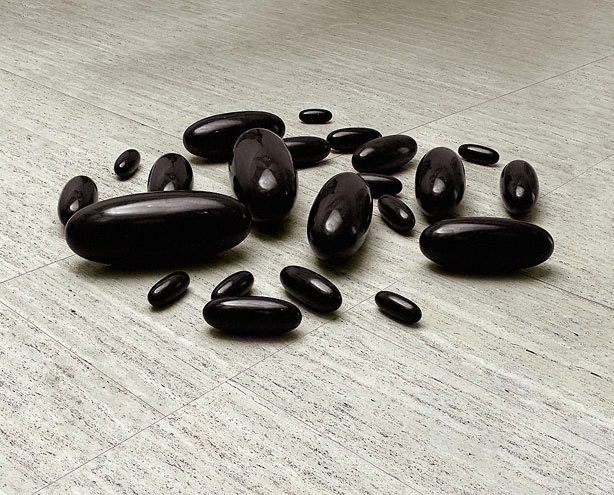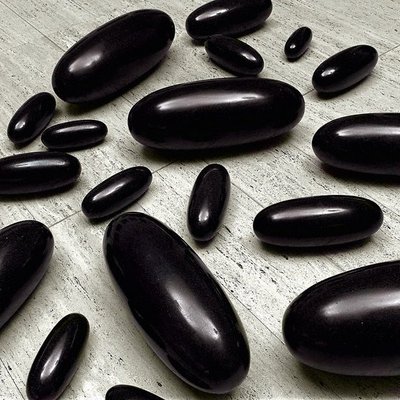-
Details
- Date
- 2000-2004
- Media category
- Sculpture
- Materials used
- Austral black granite, 22 components
- Dimensions
-
350.0 x 400.0 cm overall approx.
:
a - 1, 23.5 x 9 x 9 cm
b - 2, 23.5 x 9 x 9 cm
c - 3, 24.5 x 9.6 x 9.6 cm
d - 4, 26 x 10 x 10 cm
e - 5, 27 x 10.5 x 10.5 cm
f - 6, 28.5 x 11 x 11 cm
g - 7, 31.5 x 12.5 x 12.5 cm
h - 8, 33 x 13 x 13 cm
i - 9, 35 x 13.6 x 13.6 cm
j - 10, 37 x 14.4 x 14.4 cm
k - 11, 39 x 15.2 x 15.2 cm
l - 12, 43.5 x 16.8 x 16.8 cm
m - 13, 46 x 18 x 18 cm
n - 14, 51.5 x 20 x 20 cm
o - 15, 54.5 x 21.2 x 21.2 cm
p - 16, 60 x 23.4 x 23.4 cm
q - 17, 63.5 x 24.6 x 24.6 cm
r - 18, 66.5 x 26 x 26 cm
s - 19, 70 x 27.4 x 27.4 cm
t - 20, 77 x 30 x 30 cm
u - 21, 82 x 31.8 x 31.8 cm
v - 22, 90 x 35 x 35 cm
- Signature & date
Not signed. Not dated.
- Credit
- Gift of the artist 2004
- Location
- Not on display
- Accession number
- 298.2004.a-v
- Copyright
- © Robert Owen/Copyright Agency
- Artist information
-
Robert Owen
Works in the collection
- Share
-
-
About
The passage of time and the trace of human actions are inferred in 'Tears of history', a sculptural floor piece first conceived in 2000. The hard density of the black stone sculpture is a distillation of what the sculptor regards as the sorrows of recent Australian history, particularly race relations. The original version, entitled 'Sorry stones (tears of history)', was proposed for the Melbourne Museum and was intended to be a participatory work inscribed with the signatures of 'non-indigenous Australians who wish to apologise for the past attitudes and actions of their society which resulted in the forcible removal of indigenous children from their families.' As Owen continued, 'a clear distinction is maintained within the work between the expression of sorrow and the indigenous community to which this is expressed. This project does not attempt to represent the indigenous community or the suffering endured as a result of the stolen generation.' The project was in two parts, smaller felt-wrapped stones in one area and larger engraved stones in another. As the larger stones filled with signatures, the wrapped stones were unveiled one at a time to symbolise shifts of understanding within the Australian populace.
In this new version Owen has stepped back from inscription and a more literal symbolism and now the form and material itself, as well as its vast age, carry an imputed content. There is a solidity to this work which calls on sculpture's traditional commemorative function and the stillness and contemplative quality this room embodies rather than represents a history of place. The black granite has an intense density with an igneous layering visible which creates flashes of minute light within the black, suggestive of a concentrated image of the night sky. In its highly polished state, it seems to both reflect and yet deny light. The repetition of units, though in different scales, suggests minimalism but the materials are natural rather than industrial even though they have been 'processed' to create these forms. While entitled 'Tears of history', the stones are not tear shaped but are more like capsules, suggestive of some kind of ancient container. They also recall medicinal pills, potentially a cure though perhaps a placebo which cannot correct history just as it seeks to acknowledge it. This sculpture refers back to Owen's more poetic object and installation practice from the 1970s and '80s but has been refined though the discipline of his cube and hypercube sculptures.
-
Exhibition history
Shown in 1 exhibition
Robert Owen: different lights cast different shadows, the 2nd Balnaves Foundation Sculpture Project, Art Gallery of New South Wales, Sydney, 16 Oct 2004–28 Nov 2004
-
Bibliography
Referenced in 2 publications
-
Anthony Bond, Contemporary: Art Gallery of New South Wales Contemporary Collection, 'Objects and associations', pg.332-381, Sydney, 2006, 360, 361 (colour illus.).
-
Wayne Tunnicliffe, Robert Owen: different lights cast different shadows, the 2nd Balnaves Foundation Sculpture Project, 'Different lights cast different shadows', pg. 7-11, Sydney, 2004, 4 (colour illus.), 9, 35 (colour illus.), 36-7 (colour illus.). illustration on page 4 is a detail
-





